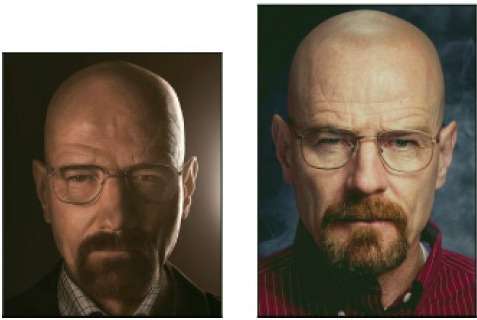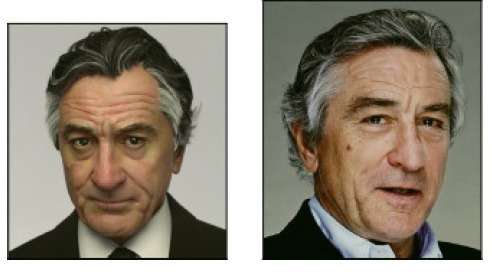Study of Virtual Images Suggests Jurors May Not Know Child Porn When They See It
Not to worry: Prosecutors can use a backup law that also makes it a crime to look at cartoons.

A new study finds that people have "considerable difficulty" distinguishing between photographs and computer-generated images of human faces, a fact the authors suggest will complicate prosecution of child pornography cases. "As computer-generated images quickly become more realistic, it becomes increasingly difficult for untrained human observers to make this distinction between the virtual and the real," says lead researcher Hany Farid, a professor of computer science at Dartmouth. "This can be problematic when a photograph is introduced into a court of law and the jury has to assess its authenticity."

In the study, which was published by the journal ACM Transactions on Applied Perception, Farid and his colleagues showed 250 subjects 60 pictures of men's and women's face, half of which were photographs and half of which were computer-generated images. "Observers correctly classified photographic images 92 percent of the time," Farid et al. report, "but correctly classified computer-generated images only 60 percent of the time."
In a second experiment, subjects were first shown 10 pairs of labeled real and virtual images, then shown the same 60 pairs used in the first experiment. They were better than the first group of subjects at identifying the computer-generated pictures, classifying them correctly 76 percent of the time. But they were somewhat worse than the original subjects at identifying photographs, classifying them correctly 85 percent of the time, perhaps because the training made them second-guess accurate perceptions.

Observers, whether trained or not, did significantly worse than the subjects in a similar study that Farid and his colleagues conducted five years ago—an indication that the quality of virtual images has improved. "We expect that as computer-graphics technology continues to advance, observers will find it increasingly difficult to distinguish computer-generated from photographic images," Farid et al. write. "Although this can be considered a success for the computer-graphics community, it will no doubt lead to complications for the legal and forensic communities. We expect that human observers will be able to continue to perform this task for a few years to come, but eventually we will have to refine existing techniques and develop new computational methods that can detect fine-grained image details that may not be identifiable by the human visual system."
Congress anticipated this development back in 1996, when it passed the Child Pornography Prevention Act. That law's definition of child pornography included "any visual depiction" that "appears to be" an image of "a minor engaging in sexually explicit conduct." Six years later, the Supreme Court overturned that aspect of the law, concluding that it was overbroad, covering constitutionally protected speech such as movie versions of Lolita or Romeo and Juliet. In 2003 Congress tried again with the PROTECT Act, which banned "obscene visual representations of the sexual abuse of children." Although the main rationale for that prohibition was preventing people caught with actual child pornography from winning acquittal by demanding that the government prove it was not virtual, the proscribed material explicitly includes drawings, cartoons, sculptures, and paintings that no one would mistake for the real thing.
On the face of it, the problem highlighted by Farid et al. should not pose much of a challenge for federal prosecutors. If it becomes increasingly difficult to prove that purported child pornography shows actual children, prosecutors can instead charge defendants with violating the PROTECT Act, which carries the same penalties as the provisions dealing with child pornography, including up to 10 years in prison for possession and a five-year mandatory minimum for "receiving" a prohibited picture, which amounts to the same thing when the image is viewed online. But PROTECT Act prosecutions are more problematic for a couple of reasons. First, prosecutors have to prove the image is obscene, meaning it "appeals to the prurient interest" and "lacks serious literary, artistic, political, or scientific value." Second, the Supreme Court has said the First Amendment forbids punishing people for mere possession of obscene material, unless it is child pornography. Hence any prosecution for merely possessing material banned by the PROTECT Act is constitutionally questionable.
Then again, when someone is caught with pictures that have been transmitted via the Internet (as is typically the case), he can always be charged with receiving them, which triggers the five-year mandatory minimum. The U.S. Court of Appeals for the 4th Circuit upheld such a conviction in a 2008 case involving Dwight Whorley, a Virginia man who was caught looking at "Japanese anime-style cartoons of children engaged in explicit sexual conduct with adults." The 4th Circuit rejected the argument that "receiving" obscene material via the Internet is essentially the same as possessing it, which the Supreme Court has said is constitutionally protected. Prosecutors also can obtain convictions for possession under the PROTECT Act through guilty pleas coerced by the threat of a receiving charge. That's what happened in a 2011 case involving cartoon pornography featuring characters from The Simpsons and a 2013 case involving "incest comics."
Farid et al. say "juries are reluctant to send a defendant to jail on an obscenity charge for merely possessing computer-generated imagery when no real child was harmed in its creation." That may be true, but jurors generally do not know the penalties a defendant faces, and lawyers are not allowed to tell them. Dwight Whorley, who had previous convictions involving cartoons as well as "digital photographs depicting minors engaging in sexually explicit conduct," received a 20-year sentence. Even if he had no record, he would have been subject to the five-year mandatory minimum just for looking at cartoons. It is unlikely that the jurors realized that—or that they would have believed it had they been told.
Editor's Note: As of February 29, 2024, commenting privileges on reason.com posts are limited to Reason Plus subscribers. Past commenters are grandfathered in for a temporary period. Subscribe here to preserve your ability to comment. Your Reason Plus subscription also gives you an ad-free version of reason.com, along with full access to the digital edition and archives of Reason magazine. We request that comments be civil and on-topic. We do not moderate or assume any responsibility for comments, which are owned by the readers who post them. Comments do not represent the views of reason.com or Reason Foundation. We reserve the right to delete any comment and ban commenters for any reason at any time. Comments may only be edited within 5 minutes of posting. Report abuses.
Please to post comments




All laws, but particularly those dealing with technology, need sunset provisions. Legislators need to be forced to periodically reexamine their output.
Doesn't matter if YOU know it is child porn or not - the "authorities" can still arrest and jail you for it. At least in our freedom-loving neighbor to the North.
http://www.animenewsnetwork.co.....ime/.78594
Dude was jailed - JAILED!!- for watching fucking ANIME!!!
I always love to mention this - also the comic that was arrested for telling an "offensive" joke - when people go on about how great Canada is.
And coming to a country near you....
Laws aren't designed to protect people from harm. Laws are designed to punish people for doing things other people find distasteful.
Yeah, lets be honest here, regardless of what you think of "child porn" (and I think anyone who exploits children should have the book thrown at them), this is really all about thought crimes. It doesn't matter if there is an actual victim or if someone did anything to anybody, it is the unclean thoughts and intentions that are the crime.
Sure, but what about the people who look at images and videos?
As shitty as we can be, dude, we DO NOT have the 'send them to prison' culture the USA has. No war on drugs, no DEA's breaking down doors, half of the crap I read on Reason doesn't happen here.
Keepin' it real.
The question you've just revealed is "Which is worse - the nanny or the bully?"
Are they not one and the same at this point?
Truly we have a sickening amount of freedom when someone can do 20 years hard time for looking at a cartoon. I should probably be charged with aiding and abetting a murderer for watching commando and not reporting Arnold.
I tend to agree....that movie has NOT held up well...
What? It's a great comedy.
Is there any chance that improved ability to make life-like CG videos will decrease the demand for real child pornography? Wouldn't this be a good thing?
yes and yes, but that would prevent the moralizers from moralizing.
sure, but coupled with the possibility that seeing cgi pedophilia will inspire people to receive the real thing its kind of a wash. same way vaporizers make people start smoking
[Citation Needed]
I have heard more evidence of vaping reducing smoking than the other way around.
Yeah but can you prove it doesn't?!?!
I remain unconvinced that merely looking at a picture, playing a video game, or watching a video can magically cause someone to want to do violence in real life. That sounds like something the social 'sciences' would come up with. If they have such desires, they likely had them before they watched the content.
It's an unlikely possibility that authoritarians will use to try to stifle freedom of speech and other rights. However, even if it is true, that would never justify banning something, because it's still 100% the fault of the person who chose to do violence. You can't blame video games, images, or videos; you can only blame the person.
It's the absurd choice frequently presented in academic circles to view man as either standing completely outside the influences of nature as some supernal being or else as a mindless automaton controlled entirely by nature. Often, as though the reality which we live every day and which is obvious even to a small child isn't even worthy of consideration.
That's what I've always argued, sg.
There are people who are obviously born wired to have sexual attraction to kiddies. Nothing can be done to counsel them out of their desires. Creating outlets for them can probably assuage them and hopefully keep them away from the real thing.
All of us are born "wired" for all sorts of desires that run contrary to common decency and the rights of others, yet most of us are somehow able to exercise some restraint and some of us even learn discipline.
The rules of evidence require photos to be authenticated.
The photo claims to have forgotten its password and never set up its security questions.
I'm not pro child pornography, but the nominal argument against it seems to be that it's a visual depiction of a highly illegal act. Okay, but so are beheading videos from ISIS and cartels and as any number of violent images that are freely disseminated. Murders aren't any more socially acceptable just because the videos exist online.
Another argument I've heard is based on the idea of 'market creation', which is to say that the dissemination of these materials creates a demand even if nobody is actually paying, thus motivating pornographers to continue their abuse. This is a highly dubious argument and one that I think is impossible to prove. But even if you accept it at face value, again, you can still make the same argument about violent imagery depicting murders and gore. There are massively popular sites that specialize in this material -- some even charge membership; is this not creating a market? Furthermore, can you argue that the children being abused would otherwise NOT be abused if a camera wasn't involved?
Really the only difference seems to be the fact that people are presumed to derive sexual enjoyment from viewing pornography, while gore and violent imagery is viewed out of morbid curiosity. But again, how can that be proven? And what difference does it make? It's entirely possible that plenty of people have viewed child pornography out of morbid curiosity and watch gore videos for sexual arousal. All we're trying to do here is regulate people's thoughts.
sounds like you think the consequences of someone's actions are more important than their motivation. I cant even.
I know, I'm a monster.
How sad it is that you even have to state this. The 'for the children' crowd is insane and illogical enough to make this necessary, however.
Yeah, it's funny how you wouldn't need to preface a statement like this with "I'm not pro-beheading videos, but..."
For some reason this issue just brings out a total lack of rationality. No sane person is in favor of child abuse, and nobody thinks it should be legal to abuse children and record it. Just as no sane person thinks that you should be able to cut a person's head off with a chainsaw and record it. However, viewing an image of child abuse will land you in jail for twenty years, while viewing an image of a brutal murder is all good. How does that work?
It makes no sense to throw someone in jail for possessing an image that they had no part in creating or facilitating, no matter how heinous the crime depicted on said image happens to be. Period. The sad thing is that we can't even have this discussion without being accused of supporting pedophiles and child abuse.
Let the government go after the people actually committing the crimes. But viewing an image or video of a crime is entirely protected under the constitution.
prosecutors have to prove the image ... "lacks serious literary, artistic, political, or scientific value."
One might surmise this is impossible on the face of it.
You'd think that.
You'd also be wrong.
The goalposts only involve influencing the feelings of twelve random people.
"Your Honor, the defense submits into evidence the Doctoral Dissertation entitled "The serious literary, artistic, political, and scientific value of so-called 'obscene' images".
And that's not even a joke.
One might also surmise that this standard was made up on the spot by foolish judges and has nothing to do with the actual constitution.
Explain to me why doctored or concocted photos are only a problem in child porn situations.
What about a purported security camera video with what turns out to be a video animation of a suspect robbing a store?
The technology is so developed that we can watch videos, live streaming, TV serials and any of our missed programs within our mobiles and PCs. Showbox
All we need is a mobile or PC with a very good internet connection. There are many applications by which we can enjoy videos, our missed programs, live streaming etc.
Final Fantasy XV Final Fantasy XV magic mug, a discoloration of the magic cup, add hot water will display a custom picture.